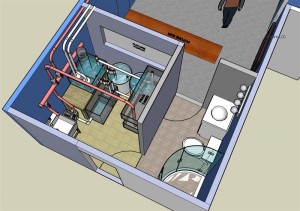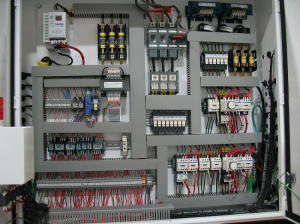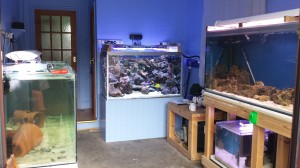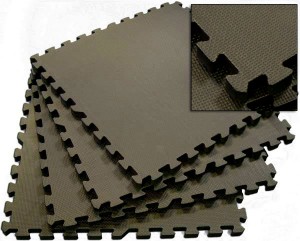Two years ago I was knee deep in the trenches of building my house. If you’ve ever built a home, you know that so many aspects require attention to detail, it’s easy to get lost and confused. If you’re a reef aquarist like me, then it is inevitable that at some level, reef aquariums factor into your construction plan. Building, or even large scale renovation, creates a perfect canvas for a reefer to create their dream working environment. There is so much that can be done when building that doesn’t greatly impact cost, which will make your aquarium maintenance life much easier down the road. Over the course of building my home, and eventually designing an entire fish level, I learned some dos and some don’ts – if you’re seeking the optimal place to pursue your hobby. Many of these ideas could easily be applied to an existing room, or used if you wish to turn a room of your home into a dedicated fish room.
Basement levels are often the perfect place to keep utilities. Pressure tanks, hot water heaters and furnaces are all loud, and take up copious amounts of space. When designing my house, the basement level was initially added to serve the sole purpose of a utility area. Upon closer inspection, it became clear it was also perfect for a fish room. Being below grade, and on a cement floor, means that there is no tank too large, and weight stress on the home’s structure becomes a non-issue when working in the basement. Utilities and aquarium equipment share a lot of similarities.
One, they both can be loud, and are often best left un-seen. Protein skimmers, sumps and other filtration devices are cool, and hardcore reef keepers love to dissect their equipment, though they don’t offer anything aseptically pleasing, especially if you seek to re-create a natural environment. Using a dedicated fish room, or in my case fish level, allows you copious amounts of working room to hide various filtration equipment. If you’re handy with building, or using a team of contractors, building or renovating is the perfect time to create the stand, cabinets and custom design YOU want. When laying out my fish room, I decided to tie two large fish only systems together, on one massive sump, which is hidden behind cabinetry which matches the rest of the home’s style and décor. Without a large environment to work with, and a lot of space up for grabs, this type of set-up would have been impossible.
Two, water borne utilities and aquarium filtration have a tendency to leak over time. I don’t care how great and responsible a reefer you are, accidents happen. Aquarium equipment was designed, built and is implemented by human beings, and sadly we make mistakes. A massive flood in an upstairs level of the home can cause thousands upon thousands of dollars’ worth of damage. In a basement on a concrete floor, it’s simply a little bit of time with a shop vac.
Three, utilities and aquarium filtration require maintenance. Yanking protein skimmers, pumps and other equipment out of sumps or aquariums makes a mess. As I mentioned in my 11 hard truths post, saltwater is damaging. If your home is littered with laminate, wood or carpeted floors, constant exposure to water causes damage. In the cases of laminate flooring, water seeps beneath the floor and sub-floor, causing the flooring to bow and eventually require replacement. On a concreate basement floor however, it doesn’t harm anything which translates to easier maintenance as you don’t need to be overly conscious about water seeping out as you rush to a sink.
Since water is already in place for your home’s utilities, plumbing in a laundry tub or other water outlet is easy, and often incurs little additional cost. If your building, then your entire plumbing system is being laid out, allowing you to choose an optimal location for water in relation to your aquariums.
I mentioned noise, and nothing dampens it better than your basement level. In the state of Maryland, building code requires basement insulation of at least R-20. This means insulating the external basement walls, and any surrounding area exposed to air penetration. While it may seem insane to insulate a space below grade, as the constant temperature of the Earth is 55 degrees, it has an awesome fringe benefit for aquarists. All that insulation keeps noise at bay, and unless you enter the sanctum of your fish room, you’d never guess your aquariums existed when on the upper levels of the home. There are a lot of spray foam products on the market, which can be used by do it yourselfers, allowing you to seal up any area where air penetration, or noise escaping may exist. A tight basement can maintain a near constant temperature, guaranteeing that changes in seasonal weather don’t affect your tanks.
When building, the door is wide open to a lot of options. I considered water storage that was recessed beneath the flooring, allowing water pumps to transport RODI water to a pressure tank, which could be tapped into when needed. This type of option would make constant RODI water creation, and retrieval practically invisible, but lends itself to some problems, were the storage containers to leak or need cleaned. I opted for an integrated above ground water creation system, which allows the same functionality, with easy access to the water storage bins. I combined this with water storage for RODI waste water, which can then be pumped into a washing machine or toward another application so it isn’t wasted.
If you’re planning on using a system such as the RENEW automatic water changer, building an entire fish room and maintenance area works perfect. I opted to have water created and pressurized by a pressure tank. That water can then be sent into a 200 gallon holding reservoir. That reservoir is connected to a pump, which moves it into a 100 gallon mixing station. The mixing station feeds right to the RENEW’s water source, and the aquarium is connected to a drain that ecologically disposes marine water outside, away from any freshwater tributary. It may sound complicated, but in reality it’s not, and the plumbing costs to put such a system in place were actually cheaper than the RENEW system itself. At the end, you literally have lots of RODI water, and marine water at your fingertips, and by flicking a few switches, you’re conducting a water change, without lifting a single bucket.
It’s vital to make sure all water pumps, RODI units and storage vats can be accessed. It’s tempting, especially when building to hide this equipment. The harder it is to get too, the longer maintenance will take. RODI units need filter and membrane changes, and pumps need serviced from time to time. Keeping your water creation area separate of the fish room allows you to leave equipment exposed and easily accessed.
Electricity and marine water are age old enemies. There is nothing more damaging to exposed electrical components than marine water, and it creates the ultimate fire hazard. When designing a fish room, think up in terms of power. I opted to mount shop grade GFCI power strips at knee level around my fish room, and paint them to blend into the walls. For controller power bars, I did the same thing, minus the paint. This keeps electrical components outside the reach of saltwater, and I found knee level to be a comfortable height to reach, when bending down to service filtration equipment. In most states, anywhere there is water and electricity in close proximity, such as an outdoor receptable or bathroom, a GFCI is code. Around marine aquariums, they are a no brainer. If you’re building or renovating, have an electrician install a GFCI outlet, if you’re simply converting an existing room into a fish room, use a GFCI capable surge protector. Believe it or not, a GFCI could save your life, especially if the aquariums are in the basement. Were electricity to infiltration your water, and you reach in while standing at ground on the basement level, you could get slammed with a powerful shock. It’s important to remember, just because your fish are swimming around happily, doesn’t mean there isn’t stray current in your tank. Since fish live in a liquid medium, within an aquarium not directly touching the ground, even if stray current is around them, since they aren’t grounded, they don’t even know it’s there. Using a GFCI should trip the outlet any faulty device is attached too, preventing major issues and current seepage. Many aquarists and experts believe stray current causes a variety of maladies in marine life.
One thing to remember when planning a GFCI outlet or set of outlets, is the AMP max. When a GFCI reaches its max amount of amps, automatically it trips the entire outlet. A commonly installed GFCI circuit is capable of handling 15 AMPS, which is enough for one well equipped moderate systems aquarium, and that’s about it. If multiple tanks, QT tanks and other equipment are your long term goals, opt for a 20+ AMP GFCI circuit, which can handle a larger load.
When designing a fish room, keeping equipment out of site is important. There are lots of ways to accomplish this. Personally, I used custom stands and cabinets to hide all my filtration. What about all the buckets, siphons and other gear we tend to have. Areas underneath stairs, and crawlspaces around basement levels, which are conditioned, make great places to hide and organize all your aquarium gear.
Nothing beats floor drains for aquarium maintenance. Not only is spilled water easily squeegeed into a drain, waste water during water changes can be run into a drain and out of the house. I installed slanted drains in each area I planned for a tank, which have a slight pitch, allowing water to run outside into an ecologically minded drainage chute. Nothing beats hooking a siphon hose to your tank, and sitting back and letting gravity do all the work for you. If you use a RENEW system like me, simply allow waste water to flow into the waste collection bin on the RENEW, and be pumped into a drain. When installed during construction, and at the time cement is poured, accessory drains incur very little extra cost.
Anyone who has any experience with concrete as a flooring material knows a few things. One, anything that falls onto concrete is likely to break, and its famous for shattering cell phones and tablet computers. Also, it’s bitter cold to walk on in the winter, and since concrete offers no give, it can cause foot and leg pain after a day of doing water changes.
To combat this, I installed high impact flooring in my fish room. This flooring often comes in tiles that look like giant puzzle pieces. It’s very easy to install, and is available in a variety of colors. Most high impact flooring is totally water proof, and using flex seal or silicone, all the linkage spots can be sealed, making it impossible for water to seep down into between flooring cracks and remain there. Not only is it comfortable on your feet, but now if you drop say a $ 250 digital refractometer, it won’t shatter into pieces. Even in upstairs fish rooms, properly installed high impact flooring can save you, in the event you have a minor spill or overflow.
Being below grade, basement levels have a reputation of staying humid, even when the rest of a home is not. Regardless, put several hundred gallons of saltwater in a room, and it will get humid. You can take care of humidity several ways. One is a simple standalone dehumidifier, tied into one of your drains so that it can constantly run. These work pretty well, but they also put off a lot of heat. If your goal was to create a fish room where the temperature stays totally constant, a dehumidifier can raise the air temperature, especially in the summer months. A better, albeit much more expensive option, is an inline whole home dehumidifier wired into your home’s duct system.
These exhaust the heat they create outside, and keep your entire home (fish room and all) at a constant humidity. As I mentioned, they cost quite a lot more than a standalone dehumidifier, although they create a more comfortable home, and healthier living space. Top end units incorporate HEPA and UVC filtration, so the air you breathe can be equally as well filtered as your reef’s water.
Back-up power:
This is an often overlooked, yet literally vital part of a fish room. If the power goes out, and you don’t have a back-up, it could mean the end of your reef keeping hobby. The best option is a propane generator that automatically activates in the event of a power outage. These units can be set-up on independent 500-1000+ gallon propane tanks, and if the power goes out, you wouldn’t even know it. That said, such a system would cost as much, if not more than your entire reef set-up. A cheaper and equally as effective option is a stand-alone generator, wired into your circuit breaker with a transfer switch.
If the power goes out, you simply fire up your generator, switch power to the circuit breaker, and flip on which circuits you wanted powered.
















0 Comments